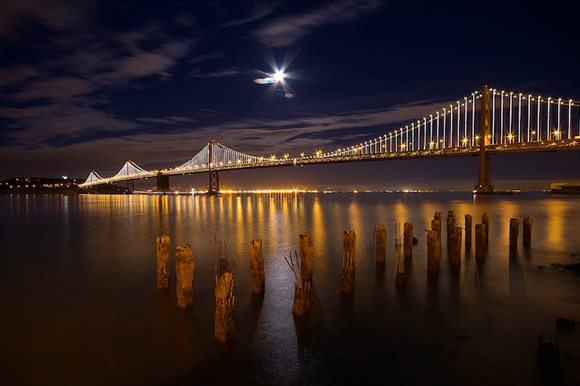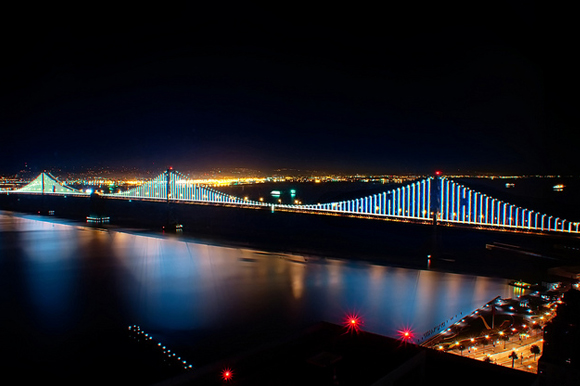The Bay Bridge in San Francisco has been living in the shadows of its more famous and, some say, more glamorous sister - the Golden Gate Bridge - since soon after its opening. But that rivalry is now a thing of the past as all eyes are on The Bay Bridge after the switching on of The Bay Lights, possibly the world’s largest light sculpture, early in March.
The Bay Lights was conceived as a celebration of the Bridge’s 75th birthday, and its organisers are hoping it will finally put The Bay Bridge in the spotlight it rightly deserves. When it first opened in November 1936, the Bridge - spanning San Francisco Bay between South Beach and Oakland, via Yerba Buena Island - was hailed as an engineering wonder… but only for about six months, when it was overshadowed by the opening of the more eye-catching Golden Gate Bridge. Yet the Bay Bridge is longer, stronger and carries more traffic than its tourist-attracting neighbour.
A privately-funded public art project costing USD$8 million, The Bay Lights uses over 30,000 metres of specially armored cabling and 728 transformer & data boxes for the power, networking & communications needed to run the 25,000 LED lights. Each luminaire represents a single pixel in this massive work of art, as Ben Davis of the organising team explains "Instead of just being a bridge, it has become a canvas."
And what a huge canvas it is! At nearly three kilometres long and over 150 metres high, The Bay Lights is certainly one of the largest sculptures in the world. And it may become one of the most famous – estimated to impact over 50 million people in the Bay Area alone and billions more seeing it in the media and online (with live webcasts nightly at www.thebaylights.org/view – this public art project certainly has some impact.
The white LED lights have been individually programmed to create a never-repeating display across the West Span of the Bridge, and the sculpture will shine from dusk until 2am every night until 2015. Costing approximately US$15.06 per night in energy bills doesn’t mean it will carry a huge carbon footprint – the LED lighting system, developed by Philips Colour Kinetics, uses 85% less energy than traditional lighting technologies, and what little energy is produced will be offset by dedicated solar panels set up elsewhere in California.
The Bay Lights emphasises the use of ‘intelligent' lighting to create value for the community in an environmentally friendly way. The interest shown in the artwork, by people from all walks of life, just goes to show that light is something people can really have a connection with. “People may not know necessarily that it is an artwork,” says the artist Leo Villareal, “but light, especially light in motion, is something we are all attracted to.”
To discuss your own light sculpture or creative lighting project, please contact Bow Jaruwangsanti on +61 2 9712 5544 or email bow@lightmatters.com.au.














